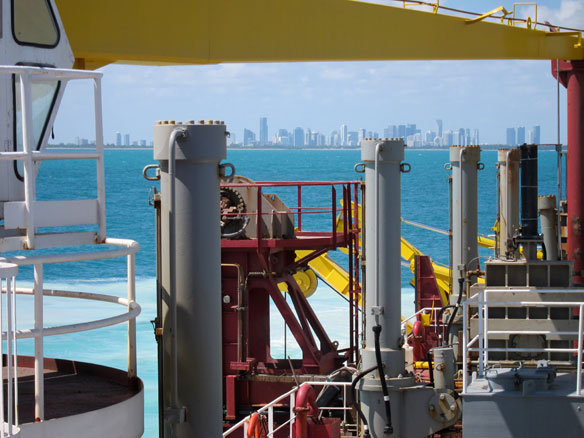
On-board a sand dredger, offshore Miami. Photograph courtesy of “Sand Wars” Award-Winning Filmmaker: © Denis Delestrac (©-2013).
“Beach nourishment projects have become commonplace along the US East and Gulf Coasts. These projects have immediate environmental impacts through burial of nearshore habitat and increased turbidity during project placement.The cumulative environmental impacts of doing this repeatedly on the same beach while conducting projects from Maine to Texas is unknown. But, we should be concerned. ” —Robert S. Young, PhD, Director, Program for the Study of Developed Shorelines, Professor, Coastal Geology, Western Carolina University
Excerpts;
Work began this week on the largest beach renourishment project in the Port Canaveral area of the five that have occurred since 1995.
The $18 million, federally funded project will restore sand to 3.5 miles of beaches, stretching from Port Canaveral’s Jetty Park to south of Cocoa Beach Pier…
Read Full Article; Florida Today (12-06-2018)
Florida has spent more than $100 million pouring more sand onto beaches in the past three years. Is it time to wave a white flag? Sun Sentinel (06-08-2018)
In South Florida’s war against the tides, it may be time to recognize that discretion is the better part of valor. For the past 70 years, the state of Florida has spent more than $1.3 billion on packing sand onto eroding beaches…
Column: High-rises spell the end for Florida beaches; By Orrin H. Pilkey and J. Andrew G. Cooper; Tampa Bay (07-25-2017)
Floridians are becoming more attuned to sea level rise and more familiar with nuisance flooding related to the rising sea. However, we believe there is less recognition that by century’s end it is likely that most of Florida’s major beaches will be permanently gone…
A swath of Miami Beach was washing away. The fix? Dump 285,000 tons of sand on it; Miami Herald (03-28-2017)
To widen a 3,000-foot stretch of Miami Beach’s shore that was washing away, the U.S. Army Corps of Engineers dumped 285,412 tons of sand on Mid-Beach, a $11.5 million project, funded with a combination of federal, state and county dollars….
Gone with the wind: storms deepen Florida’s beach sand crunch; Reuters (02-16-2018)
Costs of so-called beach renourishments are a fraction of the total, measured in hundreds of millions of dollars, but the effort is crucial for Florida’s $67 billion tourism industry. And while sand needs are surging, there is not enough to go around…
Sand washes away as quickly as it can be dumped, Bathtub Beach, FL, TCPalm News (11-17-2017)
Between 2004 and 2014, some $13.6 million was spent on beach renourishment in Martin County, Florida. About $7.1 million came from local funds — your tax dollars. In the past two years, more than $6 million from a variety of sources has been spent to renourish and restore dunes at Bathtub Beach alone…
Beach rebuilding efforts won’t stave off climate change impacts forever; Guardian UK (09-20-2018)
Factbox: Sifting Through U.S. Beach Sand Numbers; Reuters (02-16-2018)
Can Adding Sand to Beaches Save Them? How Stuff Works (04-13-2018)
The question is, can beach nourishment keep up with the ever-increasing forces of climate change or, like Sisyphus forever pushing his boulder up the hill, is adding sand to beaches an expensive, temporary fix to a long-term problem?..
“A Never-Ending Commitment”: The High Cost of Preserving Vulnerable Beaches; ProPublica (09-27-2018)
The U.S. government pays to dump truckloads of sand onto eroding beaches, in a cycle that is said to harm ecosystems and disproportionately benefit the rich…
A look at the billions of dollars behind beach renourishment: Is it worth it? WMBF (10-15-2018)
Coastal geologist criticizes beach renourishment efforts; By Robert S. Young, PhD; The State (08-17-2016)
Rob Young, who heads the Program for the Study of Developed Shorelines at Western Carolina University, said the government is subsidizing coastal development with renourishment money – and that’s costing taxpayers. Communities across the country have spent millions of dollars renourishing beaches. Those efforts encourage people to rebuild after every major hurricane…
Palm Beach Mid-Town Dredge Project, A Youtube Video (02-04-2015)
“Beach nourishment projects like this have become commonplace along the US East and Gulf Coasts. These projects have immediate environmental impacts through burial of nearshore habitat and increased turbidity during project placement.The cumulative environmental impacts of doing this repeatedly on the same beach while conducting projects from Maine to Texas is unknown. But, we should be concerned. ” —Robert S. Young, PhD, Director, Program for the Study of Developed Shorelines, Professor, Coastal Geology, Western Carolina University
Piling sand to stop erosion ultimately made the land sink, study says, NOLA (12-26-2015)
Widening beaches might bring more hazards, researchers say; Sun Sentinel (04-04-2018)
Widening beaches might be linked to an increase in accidents, according to new data. The number of ocean rescues spikes after beaches are buffed up, according to the data published in the Journal of Ocean Research…








